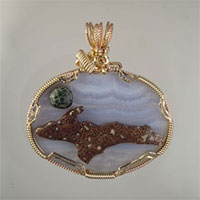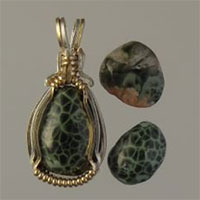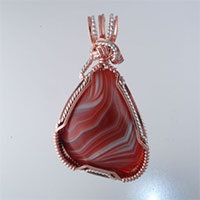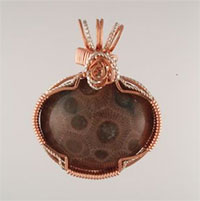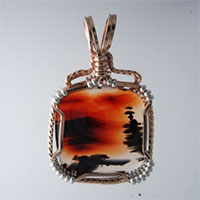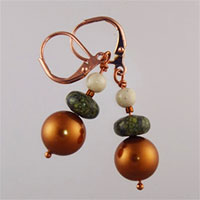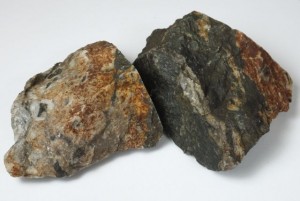
Cobaltite in the rough.
I might pretend to my wife that I know where everything in my barn is, but much of the time my shop is a great rock hunting area. While looking around the other day I located a fairly heavy (for its size) rock with a black outer seam. This indicates to me that it is some type of ore. I cut this rock in half and noticed several seams of bright, shiny, silvery metal.
This could be one of several things, I thought perhaps silver, hematite, mohawkite or cobalt. I eliminated mohawkite right away also hematite simply because the metal was much harder. This left silver and cobalt. I was pretty sure that this material came from Canada, because it was in a bucket with a couple other Canadian rocks. I took this specimen to a rock hunting buddy, Kevin, for him to give his opinion. He tested with a pocket knife and eliminated the silver choice since the rock crumbled off under knife pressure. We knew that this was cobalt. The cobalt seams are in an agatized material that even had banded areas, sudomorphs of Cobalt actually; very unusual indeed. Cobalt is considered a rare earth element with many uses, including medical and even mixed with Samariun in the manufacture of rare earth magnets. Just for trivia, the human body contains 1 mg of cobalt. Some of you are old enough to remember the Cobalt Glass from the 1950’s and before. Some of these old Cobalt bottles are now very collectable.
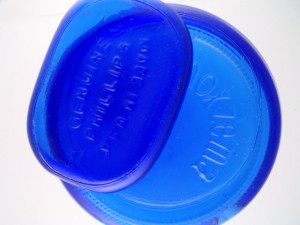
This cobalt glass from the 50's and before will bring back memories for some.
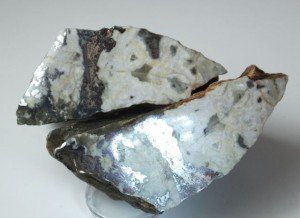
Here's the inside
After some research, I discovered that this material is called Cobaltite. Cobalt is derived from a German word, kobald, meaning goblin. So I guess it is Goblin Ore! I knew from my artist days that Cobalt was used even in ancient Egyptian times for paint coloring. Even today cobalt blue is a hue for oil paint. Early Chinese used Cobalt for the blue in their pottery glazes. Cobalt was referred to as “goblin” in medieval times because medieval miners found that the element cobalt had some troublesome effects when it released toxic vapors during the smelting process. It has since been determined that safety during smelting in those times left a lot to be desired!
Cobaltite is an cobalt iron arsenic sulfide, sometimes containing silver, copper, lead, and nickel. By looking at pictures online I could tell my piece of Cobaltite originated in the Cobalt/Gowganda region near Timiskaming District in Ontario, Canada. This is an area north northwest of Sudbury. Some Cobalt from this area is very rich in silver, which appears to be the case with my rock. Still caution will be taken because of the arsenic content associated with Cobaltite. Cobalt has unusual crystal formations that it sometimes displays. One is cubic formation and the other is Icosahedral. If you want to check on this shapes there are resources in various rock & mineral books.
To get back to the hardness of the element Cobalt, it is fairly hard, at 5.5.
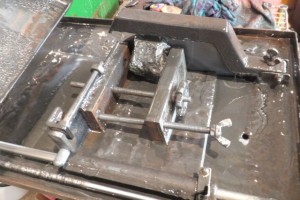
Saws get dirty with hazardous oil when cutting Mohawkite and Cobaltite.
I use the same precautions when cabbing and slabbing this material as I do when cutting Mohawkite, another metal containing arsenic. Wear a respiratory, gloves, long sleeves, use lots of water, discard the cutting oil to eliminate the possibility of cross-contamination. Be safe when you deal with arsenides and many of the copper-related minerals.
Right now, I am finishing up slabbing some Mohawkite. Both Cobaltite and Mohawkite create a black gunky oil in my saws. After finishing this messy operation I must completely clean my saws with solvent and carefully dispose of the oil by encapsulating it in concrete. I try to get my saws as clean as possible so I do not get cross contamination with new oil and old residue containing arsenic.
I’ll continue this blog later when I make jewelry from the Cobaltite. First I have to cabochon the slabs, seal them, and wrap them. I’m actually eager to see how they turn out. I’ll show you in another blog.


